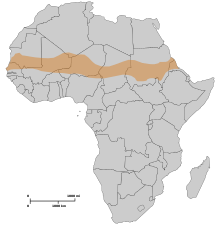Africa's Green Wall in the Sahel
Africa's Green Wall (English Great Green Wall ) or Great Green Wall of the Sahara and Sahel Initiative (short GGWSSI; English Great Green Wall of the Sahara and the Sahel Initiative ), is Africa's flagship initiative to the effects of climate change and desertification to fight. The initiative is led by the African Union . The goal is to create a large mosaic of green and productive landscape that stretches across North Africa , the Sahel and the Horn of Africa . The reason is to prevent further desertification in the Sahel zone.

role models
China's Green Wall or the projects initiated by Thomas Sankara in Burkina Faso from 1983 to 1987 serve as models , which, however, were destroyed by the successor governments after his assassination. Under the presidency of Olusegun Obasanjo , the AU adopted the project.
There are also similarities with the Barrage vert and the more decentralized Green Belt Movement , the main initiator of which is Nobel Prize winner Wangari Maathai .
history
The project was approved by the African Union in July 2005 .
Based on the idea of drawing a line (at least 15 km wide and 7,775 km long) of trees from west to east through the African desert (from Dakar to Djibouti ), the concept of the Great Green Wall evolved into a mosaic of interventions, which address the challenges of the people in the Sahel and the Sahara. As a programming instrument for rural development , the general goal of this sub-regional partnership is to strengthen the resilience of people and the natural systems with their intact ecosystems in this region, to protect rural cultural heritage and to improve the living conditions of the local population.
The GGWSSI is a global response to the combined effect of land degradation and drought in rural areas and contributes to improved local incomes. The initiative is a partnership that supports the efforts of local communities for the sustainable management and use of forests, pastures and other natural resources in arid areas. Furthermore, the aim is to help mitigate and adapt to climate change and to improve food security in the Sahel and the Sahara.
Attendees
Eleven African countries were initially involved in the project:
In the meantime (as of November 2019) "the initiative is now going beyond the Sahel zone, a total of 21 African countries are participating."
the other countries are:
Realization
Until the end of 2009 the project could only show progress in Senegal. Trees over a total length of 525 km have been planted. Senegal , which loses around 50,000 hectares of land to the Sahara every year , is thus taking the lead.
In 2012, critics complained that a verbatim implementation in the form of a continuous “green strip” was ecologically and socially inefficient. Since desertification is spreading unevenly, decentralized approaches are more promising. The planting is promising where the local residents are won over to actively participate. In the case of a major, central project, however, there is a risk that the funds will flow into national forest ministries without having any lasting effects on site. The African Union has adapted its program to these points of criticism. Those responsible now prefer to speak of “mosaic” than “wall”. The project focus is no longer the massive planting of trees. Rather, it is important to support many small projects rooted in the village communities and to preserve existing trees.
By the beginning of 2017, 15 percent of the originally planned trees are said to have been planted, for example in Senegal and Burkina Faso. In Senegal alone, twelve million trees have been planted over a length of 150 km and an area of 40,000 hectares - mainly native species such as acacias that can cope with drought. Compared to the Algerian Barrage vert , where more than half a million hectares were planted by the mid-2000s, this result is still quite modest.
Web links
- greatgreenwall.org
- Great Green Wall for the Sahara and the Sahel Initiative
- Agence Panafricaine de la Grande Muraille Verte (English) (French)
- Planting a wall , article at 3sat / nano, September 3, 2007
- FAO: Action Against Desertification
Individual evidence
- ↑ Reversal of the desert advance
- ^ Sankara - The upright man (French title L'homme intègre , German title Sankara - Der Che Afrikas), documentary film, director: Robin Shuffield, 2006
- ^ Green Belt Movement
- ↑ Push for 'Great Green Wall of Africa' to halt Sahara . In: BBC News . June 17, 2010 ( bbc.com [accessed January 30, 2017]).
- ↑ GGWSSI | Great Green Wall for the Sahara and the Sahel Initiative. Retrieved January 30, 2017 (English).
- ↑ Africa is planting a new 7,000 km long “Green Wall” for the climate by Katherine Curtiss, globalcitizen.org May 9, 2016
- ↑ Africa's Green Strip , by Roman Goergen, Technology Review June 7, 2017
- ↑ Why there is a huge green wall in Africa , by Milena Zwerenz, Ze.tt September 28, 2017
- ↑ Green Wall: What became of Africa's 8,000-kilometer-long green strip , trendsderzukunft.de October 6, 2017
- ↑ National Geographic News, December 28, 2009: Africa-wide "Great Green Wall" to Halt Sahara's Spread?
- ↑ Alexander Göbel, ARD radio studio West Africa from February 21, 2010: A green belt against the sandy desert ( Memento from February 22, 2010 in the Internet Archive )
- ↑ Technology Review: Africa's Green Belt. Retrieved June 25, 2017 .
- ↑ Mark Hertsgaard : Quer durch Afrika , in: Le Monde diplomatique , German edition, November 2011, pp. 9-10.
- ↑ Technology Review: Africa's Green Belt. Retrieved June 25, 2017 .
Coordinates: 13 ° 20 ′ 0 ″ N , 13 ° 20 ′ 0 ″ E